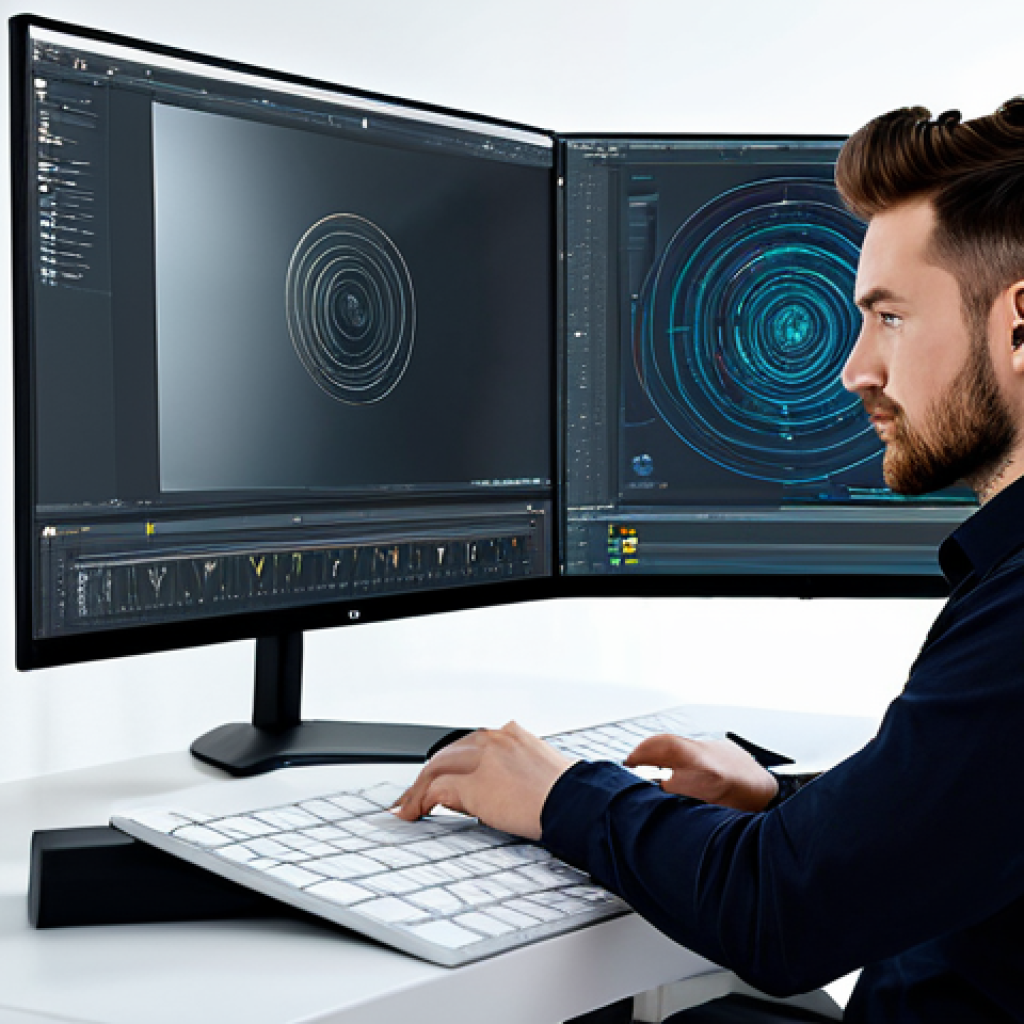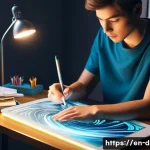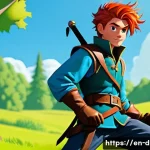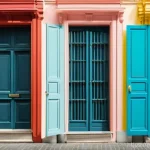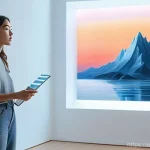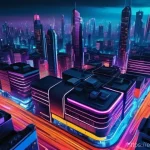If you’re anything like me, you’ve probably felt that familiar blend of excitement and a tiny bit of dread when a major software update for your favorite digital art tool drops.
Just when you’ve finally mastered your workflow, *poof*, a whole new set of possibilities (and learning curves!) emerges. I’ve personally spent countless hours diving into these updates, and honestly, the sheer pace of innovation right now is breathtaking.
We’re not just talking about minor bug fixes anymore; these are game-changing advancements, often integrating cutting-edge AI-driven tools that truly redefine what’s possible in terms of efficiency and creative freedom.
From mind-boggling new brushes that react like real-world media to intelligent automation that takes the drudgery out of repetitive tasks, the landscape of digital art is evolving faster than ever.
It feels like just yesterday I was wishing for a feature, and now it’s here, perfectly integrated. These aren’t just technical upgrades; they’re pushing the very boundaries of artistic expression, helping us unlock new styles and achieve results that were once purely theoretical.
Let’s dive into the details below.
It truly feels like we’re living in a golden age for digital artists, doesn’t it? Every few months, our beloved software gets these groundbreaking updates that don’t just tweak things; they fundamentally change how we create.
I’ve personally been blown away by the sheer ingenuity developers are pouring into these tools, making the impossible achievable and the tedious enjoyable.
Embracing the AI Revolution in Creative Workflows

One of the most jaw-dropping transformations I’ve witnessed recently is the pervasive integration of Artificial Intelligence into our everyday digital art tools.
When I first heard about AI being used in art, I admit I was a bit skeptical, worried it might dilute the human element. But experiencing it firsthand has been nothing short of revelatory.
We’re not talking about AI taking over; we’re talking about it becoming an incredibly powerful co-pilot, handling the monotonous tasks so we can focus purely on the creative vision.
For instance, the automatic background removal tools have become so sophisticated, it’s like having a dedicated assistant meticulously selecting pixels for you in seconds, something that used to eat up an hour or more of my time.
This leap forward in efficiency means more time for experimentation, more time for client work, and frankly, more time for life outside the screen. It’s an evolution that feels natural and empowering, pushing the boundaries of what a single artist can achieve without compromising their unique style.
1. Intelligent Brush Engines and Artistic Filters
I remember the days of painstakingly trying to replicate natural media textures digitally. It often felt like a compromise. Now, with AI-powered brush engines, the realism is astounding.
My personal experience with the latest update to my go-to painting software, for example, introduced a watercolor brush that genuinely reacts to pressure, tilt, and even ‘wetness’ in a way that mimics real pigment on paper.
It’s not just a fancy effect; the underlying AI analyzes your stroke, predicts how colors would blend and bleed, and renders it with uncanny accuracy.
This has allowed me to push my traditional art influences into my digital pieces with a fluidity I never thought possible. Similarly, new artistic filters, driven by deep learning, don’t just overlay effects; they understand the composition and content of your image, intelligently applying styles that enhance, rather than merely decorate, your original artwork.
It’s like having a master art restorer who also happens to be a creative genius at your fingertips, offering suggestions and refinements that spark new ideas.
2. AI-Powered Automation and Smart Features
Beyond the brushes, the subtle, smart features are where AI truly shines for workflow optimization. I’ve been experimenting with a new automatic image upscaler that, unlike previous pixel-doubling methods, actually *invents* detail based on learned patterns, making low-resolution sketches perfectly usable for large prints.
This has saved countless hours of redrawing and refining. Another game-changer for me has been the intelligent selection tools that understand complex shapes and textures.
Trying to select individual strands of hair, for instance, used to be a nightmare. Now, the AI understands the *concept* of hair, not just pixels, making the selection process almost instantaneous and remarkably precise.
This frees up mental bandwidth and artistic energy, allowing me to focus on the expressive aspects of my art rather than getting bogged down in the minutiae of technical execution.
It’s not magic, but it feels pretty close sometimes.
Unlocking New Dimensions with Enhanced 3D Integration
For years, digital art primarily meant 2D, with 3D being a separate, often intimidating realm. But honestly, the latest updates have blurred these lines so beautifully that it feels like two sides of the same creative coin.
I’ve personally found myself dipping into 3D environments much more frequently, not necessarily to create fully rendered scenes, but to generate dynamic poses for characters or to mock up complex architectural elements that would be agonizing to draw in perspective.
The ease with which these 3D elements can now be imported, manipulated, and even painted directly within a 2D painting environment is revolutionary. It’s opened up a whole new playground for my imagination, allowing me to tackle more ambitious compositions and explore perspectives that were previously beyond my comfort zone.
1. Seamless 3D Model Import and Manipulation
The friction associated with bringing 3D models into a 2D canvas has practically vanished. My recent software update integrated a drag-and-drop system for common 3D formats, and the performance is shockingly good.
I can rotate, scale, and light a 3D model right there on my canvas, seeing how it interacts with my painted elements in real-time. This has been particularly helpful for character design, where getting the exact angle and lighting for a dynamic pose used to involve complex perspective grids or clumsy external programs.
Now, I can pose a generic mannequin model, adjust the camera, and then paint directly over it, ensuring anatomical accuracy without sacrificing spontaneity.
It feels incredibly intuitive, almost like sculpting with light and shadow before applying color.
2. Direct 3D Painting and Texturing
What truly blew my mind, though, was the ability to paint directly onto 3D models *within* my primary 2D painting application. Before, you’d have to export textures, load them into a dedicated 3D texturing program, paint, save, and re-import – a clunky, creativity-stifling process.
Now, I can use my favorite brushes and techniques to paint directly onto a character model, seeing how the textures wrap around its form in real-time.
It’s an incredibly tactile experience, almost like painting on a real sculpture. This has been a game-changer for developing consistent visual styles across both 2D and 3D assets, ensuring that my character’s skin texture or the worn metal of their armor looks just as good in a static illustration as it would in a rendered scene.
It’s a testament to how developers are truly listening to artists’ needs for integrated, holistic workflows.
Revolutionizing Performance and User Experience
Honestly, sometimes the most exciting updates aren’t the flashy new features, but the ones that make everything just *feel* better. I’m talking about the under-the-hood optimizations that shave seconds off load times, make brushes feel smoother, and generally remove those little frustrating hiccups that break your creative flow.
When I first got my hands on the latest patch, I immediately noticed how much more responsive everything felt, even on massive canvases. It’s those subtle improvements that add up to a significantly less stressful and more enjoyable creative process, allowing me to stay immersed in my work for longer periods without feeling the drag of technical limitations.
1. GPU Acceleration and Multi-Core Optimization
The jump in performance from purely CPU-bound operations to leveraging the power of modern GPUs has been monumental. I run a pretty beefy setup, but even I was surprised by how much snappier everything became.
Applying complex filters to high-resolution images, for example, used to be a “go make a cup of tea” moment. Now, it’s often instantaneous. The developers have clearly invested heavily in optimizing their code for multi-core processors and graphics cards, meaning tasks that once hogged resources are now handled with effortless grace.
This directly translates to more fluid brush strokes, less lag when manipulating layers, and quicker exports, all of which mean more time actually creating and less time staring at a loading bar.
2. Intuitive UI/UX Refinements for Enhanced Productivity
Beyond raw speed, the thoughtful tweaks to the user interface and overall user experience have significantly boosted my productivity. I’ve noticed small but impactful changes, like customizable shortcut menus that pop up exactly where my stylus is, or intelligently organized brush presets that learn my preferences.
These might seem minor, but they eliminate tiny moments of friction throughout the day. It’s like the software is learning how *I* work, anticipating my next move, and putting the tools right where I need them.
This level of personalized interaction makes the creative process feel less like battling a computer and more like dancing with a collaborative partner.
| Feature Category | Previous Experience | Latest Software Update Impact | Artist Benefit |
|---|---|---|---|
| AI-Powered Tools | Basic auto-selection, limited style filters. | Advanced intelligent selection, generative fill, realistic brush dynamics. | Massive time savings on tedious tasks, expanded creative possibilities, realistic artistic effects. |
| 3D Integration | Clunky import/export, separate workflows. | Seamless drag-and-drop, direct 3D painting, real-time lighting. | Improved perspective accuracy, faster character posing, cohesive 2D/3D art pipelines. |
| Performance | Frequent lag on large files, slow filter application. | GPU acceleration, multi-core optimization, instant feedback. | Smoother workflow, reduced frustration, more time for creative exploration. |
| User Experience | Generic UI, repetitive menu navigation. | Customizable menus, AI-driven suggestions, intuitive tool organization. | Enhanced productivity, personalized workflow, deeper creative immersion. |
Bridging the Gap with Cloud-Based Collaboration
In a world that’s increasingly interconnected, it felt like digital art was sometimes lagging behind in terms of real-time collaboration. I remember trying to work on projects with other artists, passing files back and forth, dealing with version control nightmares.
It was a headache, to say the least. But thankfully, the latest software updates have made huge strides in integrating robust cloud-based collaboration features, turning what was once a solitary pursuit into a genuinely shared experience.
This isn’t just about sharing a finished piece; it’s about building a masterpiece together, in sync, regardless of geographical distance. It’s truly amazing to see your collaborator’s brush strokes appearing on your canvas in real-time, sparking a dynamic back-and-forth that feels incredibly natural.
1. Real-Time Shared Workspaces
I recently had the opportunity to test out a beta feature that allowed me to collaborate on a painting with an artist literally halfway across the globe.
The experience was astonishingly fluid. We could both work on the same canvas simultaneously, see each other’s cursor movements, and even leave real-time notes and critiques directly on the artwork.
This isn’t just for large studios; it’s a game-changer for independent artists looking to co-create or for art teachers providing direct feedback. The days of sending massive PSD files back and forth, praying for no version conflicts, feel like a distant memory.
It has fostered a sense of creative synergy that elevates the final output beyond what either of us could have achieved alone.
2. Integrated Asset Libraries and Version Control
Beyond active co-creation, the improvements in cloud-based asset management have been incredibly beneficial. Many updates now include integrated cloud libraries where I can store and access my custom brushes, palettes, and even frequently used textures from any device, anywhere.
This has eliminated the headache of synchronizing assets manually across my desktop and tablet. Furthermore, the robust version control systems built into these cloud platforms are a lifesaver.
I can easily revert to previous iterations of a project, compare changes, and ensure that no precious work is lost. It’s like having an invisible assistant meticulously backing up every stroke, offering a safety net that lets me experiment more boldly without fear of irreversible mistakes.
A Deeper Dive into Customization and Personalization
One of the most profound aspects of these recent updates, from my personal perspective, has been the push towards even greater customization and personalization.
It’s not just about changing a few hotkeys anymore; it’s about sculpting the entire software environment to perfectly fit your unique workflow and creative preferences.
I’ve always believed that the less friction there is between your idea and its execution, the purer the art. These updates are truly excelling at removing that friction, allowing the tools to disappear into the background so your artistic voice can shine through unimpeded.
1. Tailored UI Layouts and Shortcut Mapping
I’ve spent years refining my own personal workspace, moving panels, adjusting toolbars, and meticulously setting up keyboard shortcuts. The latest software releases have taken this a step further, allowing for truly dynamic UI layouts that can adapt to different tasks.
For instance, I can now have a minimalist interface for sketching and a more comprehensive one for detailed painting, switching between them with a single click.
Moreover, the flexibility in remapping almost every single function to a custom shortcut, whether on my keyboard, a pen button, or a peripheral device, has made my workflow incredibly ergonomic and efficient.
It feels like the software is an extension of my hands, responding instinctively to my every command.
2. Advanced Brush Engine Parameter Control
For those of us who love to tinker and create our own unique tools, the expanded control over brush engine parameters is nothing short of a dream come true.
I’ve discovered new ways to combine different brush characteristics – texture, scatter, flow, and dynamics – to create truly unique brushes that are perfectly suited to my specific artistic style.
It’s like having a miniature physics lab for brushes, allowing me to precisely control how digital “pigment” interacts with the “canvas.” This granular level of control, while initially a bit daunting, empowers me to craft tools that feel truly personal, giving my digital art a distinctive fingerprint that wouldn’t be possible with standard presets.
It’s an artist’s playground for truly unique expression.
Staying Current: Resources and Community Engagement
Let’s be real, keeping up with the breakneck pace of these software updates can feel overwhelming. I’ve definitely had moments where I’ve felt a bit lost, wondering where to even begin with a massive new feature set.
But what I’ve consistently found with these latest updates is a much stronger emphasis on supporting the user through the learning curve. Developers are clearly understanding that releasing powerful tools isn’t enough; they need to ensure artists can actually *use* them effectively and integrate them into their existing practices.
This focus on education and community has been a massive relief, turning potential frustration into genuine excitement.
1. Enhanced In-App Tutorials and Learning Pathways
Gone are the days of hunting through obscure forums for answers. Many of the updated applications now feature beautifully integrated, interactive tutorials directly within the software itself.
I recently explored a new feature and found a step-by-step guide pop up, demonstrating its core functions with clear, concise instructions and even short video snippets.
Some even offer “learning pathways” that guide you through a series of lessons based on your skill level and creative goals. This on-demand, context-aware learning has significantly reduced the time it takes for me to get comfortable with new tools, allowing me to spend more time creating and less time reading instruction manuals.
It’s a smart move that benefits everyone.
2. Developer-Led Workshops and Community Forums
Beyond the in-app help, the commitment to fostering vibrant online communities and providing direct access to the creators themselves has been truly inspiring.
I’ve participated in several live Q&A sessions and workshops hosted by the software developers themselves, where they not only demonstrate new features but also answer user questions in real-time.
This direct line of communication feels incredibly valuable, creating a sense of being heard and understood as an artist. Furthermore, the official forums and social media groups dedicated to these updated versions are buzzing with activity, with artists sharing tips, troubleshooting issues, and showcasing their work.
This collective knowledge base, fueled by enthusiastic users and responsive developers, makes navigating the new landscape so much more approachable and enjoyable.
It transforms a solo learning journey into a shared adventure.
Closing Thoughts
It truly feels like we’re not just witnessing an evolution in digital art software; we’re actively participating in a revolution. These recent updates aren’t merely incremental improvements; they are fundamentally reshaping how we approach creativity, making once-daunting tasks accessible and opening up entirely new artistic avenues.
As an artist, I feel more empowered than ever, with tools that seem to anticipate my needs and amplify my vision. The future of digital art, filled with seamless workflows, intelligent assistance, and boundless collaborative potential, is not just arriving—it’s already here, and it’s exhilarating.
Useful Information to Know
1. Always check system requirements before updating. While many updates bring performance boosts, some introduce new features that might require more powerful hardware, especially for complex AI or 3D tasks. A quick check can save you a lot of frustration.
2. Back up your projects and custom assets frequently. Before embarking on a major software update, it’s always a wise practice to back up all your ongoing projects, custom brushes, palettes, and workspaces. This ensures peace of mind and prevents potential data loss.
3. Dedicate time to explore new features. It’s easy to stick to familiar workflows, but the real power of these updates often lies in features you haven’t yet discovered. Set aside dedicated time to watch tutorials, read release notes, or simply experiment freely.
4. Engage with the community and developers. Many software companies host active forums, Discord channels, and social media groups. Participating in these communities can provide invaluable tips, troubleshooting advice, and even direct access to developers for feedback or bug reporting.
5. Consider gradual adoption of new workflows. You don’t have to overhaul your entire creative process overnight. Try integrating one new AI tool or 3D feature into a non-critical project first, then gradually incorporate it into your main workflow as you gain confidence.
Key Takeaways
The latest digital art software updates represent a significant leap forward, profoundly impacting how artists create. Key advancements include the sophisticated integration of AI for tasks like intelligent selections and realistic brush engines, seamless 3D model import and direct painting capabilities, and substantial performance enhancements via GPU acceleration.
Additionally, improvements in user experience, robust cloud-based collaboration tools, and extensive customization options are empowering artists with unprecedented efficiency and creative freedom.
These developments are fostering a more intuitive, interconnected, and powerful artistic environment.
Frequently Asked Questions (FAQ) 📖
Q: With updates dropping so frequently, how do you personally manage to stay on top of new features without feeling completely swamped?
A: Oh, this is such a common feeling, isn’t it? I swear, sometimes a new patch drops right when I’ve finally memorized all the keyboard shortcuts for the last one!
My secret, if you can call it that, is a mix of strategic diving in and accepting I won’t master everything overnight. When a big update lands, I usually check out the official release notes first – not every single line, but I scan for the “wow” features that genuinely excite me or directly address a pain point in my workflow.
Then, I pick one or two of those to really dig into. Maybe it’s a new brush engine, or a specific AI-driven filter. I’ll carve out an hour or two specifically for experimentation, almost like a play session.
The trick is not to try and absorb it all at once; that’s a recipe for burnout. It’s more about a continuous, curious exploration rather than a frantic scramble.
And honestly, some features I just let simmer until I genuinely need them for a project. It’s a marathon, not a sprint, and there’s no prize for learning it all in one go!
Q: Beyond the hype, how are these new
A: I-driven tools actually changing day-to-day work for digital artists like yourself? A2: This is where it gets really exciting for me, and honestly, it’s not just hype.
I used to spend a ridiculous amount of time on certain repetitive tasks that just had to be done – things like perfect selections for compositing, or upscaling an older sketch without it turning into a pixelated mess.
Now, with these intelligent tools, it’s like having a super-fast, endlessly patient assistant. For instance, the new ‘intelligent fill’ features in some programs?
They’re uncanny. I can literally remove an element from a complex background and it fills it in seamlessly, saving me a good 20-30 minutes of painstaking cloning or patching.
Or think about automatic color grading suggestions – they give me a fantastic starting point in seconds, allowing me to focus on the artistic nuances rather than wrestling with sliders.
It’s not about the AI doing the art for me; it’s about it handling the technical drudgery, freeing up my brain and my hands to actually create. It genuinely feels like these tools amplify my skills, letting me achieve professional results much faster than I ever thought possible, leaving more time for the truly creative parts.
Q: You mentioned these updates are ‘pushing the very boundaries of artistic expression.’ Can you elaborate on how they’re truly doing that?
A: Absolutely. It’s not just about speed or convenience, though those are huge bonuses. What I’ve found is that these advancements, especially the AI-powered ones, are enabling entirely new approaches to art that felt almost theoretical before.
Take, for example, the new generative brush systems some tools are implementing. They aren’t just predefined strokes; they react to pressure, speed, and even the existing colors on your canvas in ways that mimic real-world media with an almost spooky accuracy, but then they transcend it.
I’ve found myself experimenting with textures and blending modes that I simply couldn’t achieve with traditional tools or even older digital methods. It’s almost like having a new sense.
Or consider AI-assisted style transfer – it’s not just a filter; it can analyze a masterpiece and apply its unique stylistic elements to your own work in a way that feels organic and inspiring, not just a cheap overlay.
This isn’t about replacing the artist; it’s about providing us with a whole new palette of possibilities, pushing us to explore aesthetics and techniques that were previously inaccessible, sparking totally fresh ideas.
It genuinely feels like my imagination now has fewer technical limitations holding it back.
📚 References
Wikipedia Encyclopedia
구글 검색 결과
구글 검색 결과
구글 검색 결과
구글 검색 결과
구글 검색 결과
